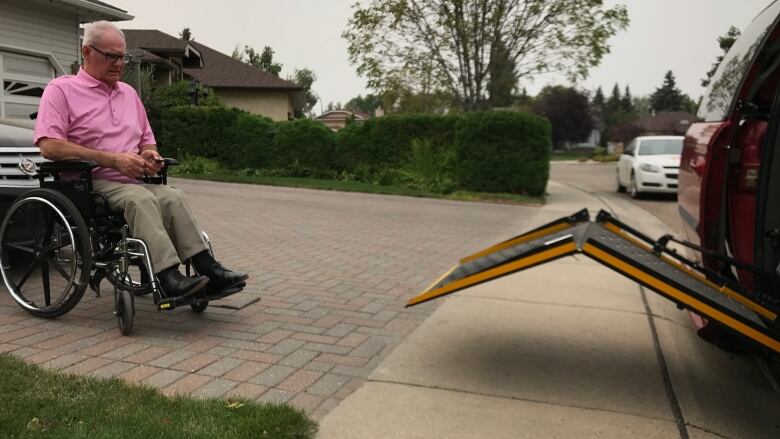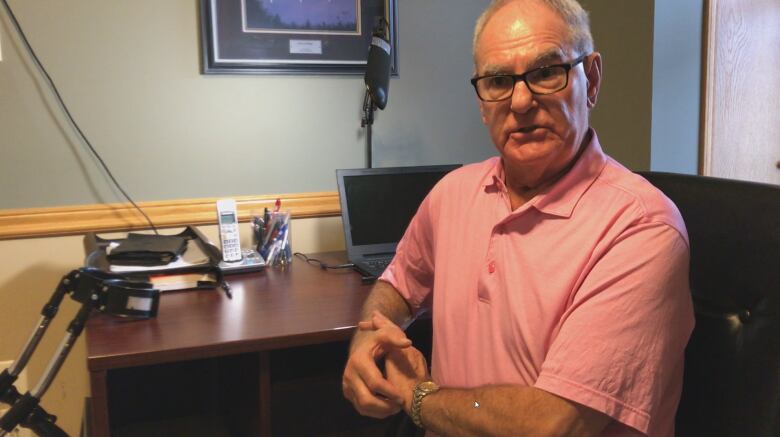Saskatoon man says accessible city parking spots not wide enough for wheelchair vans
Al Muir is also calling on the city to create a comprehensive accessible parking policy

A Saskatoon man says the city needs toincrease the number of accessible parking spots wide enough for people who need to unload wheelchairs and mobility aids from their cars.
Al Muir has lived with the residual effects of polio since he was 10, but it was only five years ago, at the age of 68, that he had to buy a wheelchair to help him get around when his crutches won't do.
After purchasing a wheelchair van last year, he was dismayed to find how hard it was to find an accessible parking spot, especially in the downtown core, that was wide enough to accommodate his vehicle andallow him to deploy the ramp he uses to roll out of the vehicle.

"A normal width parking stall will not allow you to deploy the mobility aid, move it alongside the vehicle, open the door fully and have the passenger or user exit," said Muir.
"You need about 11 feet [3.3 metres]" plus another fivefeet [1.5 metres] on the sidewalk, he said "to make that happen without damaging the car next to you, or without impeding the ability of the individual to get out of their car."
Al Muir says #saskatoon needs more parking spaces wide enough to accommodate wheelchair vans. #yxe pic.twitter.com/7zKodb3fif
—@gq_in_skThere are some accessible parking stalls that are wide enough, he said, pointing to a few spaces by the Mendel Art Gallery and another space at the city-owned lot by the YMCA.
"Confusingly, the newest parking lot, adjacent to the PotashCorp children's rides,are not 11 feet, they're much narrower," he said.
More spots needed
Muir not only wants more accessible parking spaces that meet these standardsbut some consistency, which is why he's calling on the city to create a comprehensive accessible parking policy.
Other, more specific ideas include:
- One of every six accessible city-owned parking spots to be 3.3 metres wide and adjacent to a sloped curb.
- 20 accessible parking spots for every 1,000 parking spots in the downtown area.
- A change to the bylaw for private lots requiring their owners to make the same changes.
Muir said, based on his research with the Saskatchewan Abilities Council and Golden Mobility a company that does wheelchair van conversions, there are 9,829 active handicap parking permits issued within the city and about 100 wheelchair vans.
"The city has implemented an extensive network of bike lanes in the city core that is used by several hundreds of bikers during our short summer and a mere handful of dedicated biking enthusiasts during our five-month winter," he wrote to the Saskatoon Accessibility Advisory Committee in a recent letter.
"Surely, for 10,000 users, we can consider upgrading our accessibility bylaws to a standard enjoyed by an overwhelming number of jurisdictions in North America."
Widening existing parking spots will cost money, Muir acknowledges, which is why he's asking the city to implement the changes over a period of time.
Muir will present his ideas to the committee on Sept. 8.
"I'm certainly looking for some action on it," he said.
City offers loading zones
The city does allow people with accessible parking permits to park in loading zones.
"We also provide a $20-a-year permit to add on that allows for free unlimited parking," said Andrew Hildebrandt, the city's director of community standards, via email.
"However we do recognize there is the need for some policy review and redevelopment. The parking program is currently facing many policy reviews to adapt to our evolving city."
A report, expected in November, "will outline and attempt to prioritize the many policy reviews being considered," he added.
The city's accessibility action plan, launched in 2008, also calls for the installation of curb ramps in priority zones around the city.












_(720p).jpg)


 OFFICIAL HD MUSIC VIDEO.jpg)
.jpg)



























































































